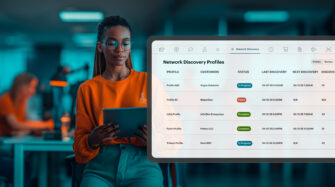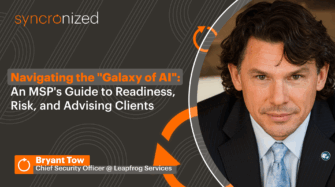Table of contents
- Why Change Management Automation Matters for MSPs and IT Teams
- How Change Management Automation Drives Client Trust and Business Growth
- How Change Management Automation Tools Work
- Limitations of Traditional Change Management Tools
- Integrate Change Automation Management into Your Workflow
- Connect Change Automation with Syncro
- Frequently Asked Questions
Change management automation supports MSPs and IT teams in introducing updates to software, hardware, or configurations without causing outages and compliance gaps. When fully integrated, change management automation builds trust with clients and reduces the time needed to handle tasks. It shows them their systems are handled with care and provides your team with a clean audit trail to work from, anywhere in the process.
The team defines what qualifies as a change, who approves it, and how it gets implemented, all within a system that tracks and stores every step.
In this post, we’ll walk through how change management automation helps MSPs and IT teams reduce risk, streamline operations, and turn manual change processes into automated systems.
Why Change Management Automation Matters for MSPs and IT Teams
Frequent system changes can make workflows chaotic and complex when your team manages multiple tenants. Without structure, even small updates create risk.
Change management automation gives MSPs and IT teams a built-in layer of protection. Every step is documented, and standardizes how changes are proposed and approved. Consistency in automation gives your team an easier workflow to manage and audit multiple clients.
When change management automation is used well, it helps with:
- Tracking visibility: Track and audit every change across client systems, from minor tweaks to major overhauls
- Approval workflows: Set standardized review and sign-off processes for high-impact updates
- Historical context: Keep asset histories clean, accurate, and easy for techs to reference
- Compliance alignment: Stay on track with internal SLAs and external audit requirements, reducing overhead.
An automatic system for documenting changes creates repeatable processes that make every system update safer, cleaner, and easier to scale.
How Change Management Automation Drives Client Trust and Business Growth
Implementing change management automation doesn’t just streamline internal processes — it improves how your MSP or IT team delivers value externally. When updates are handled with transparency and control, clients gain confidence in your capabilities, and your team gains room to grow. Here are key outcomes and considerations:
- Client confidence through transparency: Automation shows clients you’re not making reactive decisions. Every change is visible, documented, and accountable. This builds long-term trust and reduces the need for micro-managed relationships.
- Improved SLAs and reliability: Automated change processes help you meet service-level agreements more consistently. Faster approvals and clear audit trails reduce the likelihood of missed steps or miscommunication.
- Stronger compliance posture: For clients in regulated industries, proof of change control is a must. Automation gives you an edge by embedding compliance into everyday operations, making audits faster and less stressful.
- Higher team productivity: With repetitive change tasks automated, your technicians spend less time on manual busywork and more time focusing on strategic tasks that drive customer value and satisfaction.
- Scalable operations: As your client base grows, manual change tracking becomes a liability. Automation scales with your business, enabling your team to handle more systems without sacrificing accuracy or speed.
- Competitive differentiation: Not all MSPs offer robust change control. Showcasing your automation capabilities can serve as a market differentiator when pitching to new clients or renewing existing contracts.
How Change Management Automation Tools Work
Change management automation creates a clear, repeatable workflow for updates moving through your system. This includes the initial idea, final execution, and continued recordkeeping. Instead of relying on memory or manual logs, each step is defined and tracked.
Here’s what that process looks like in practice:
Initiate the change: A technician proposes a system update such as applying a patch, modifying a script, or adjusting firewall settings. They log what’s changing and why it’s needed.
Request approval: If the change has potential risk, the platform can trigger a workflow requiring review. Senior technicians or client stakeholders are notified to sign off before the process continues.
Execute and monitor: Once approved, the task progresses to the execution stage. This can involve manual work or automated scripts that follow predefined steps. The system captures everything in real time.
Document the outcome: After execution, the platform logs what happened, when, and who was responsible. If a future issue persists, you have a full trail to investigate or revert.
Larger enterprises may use enterprise-grade ITSM tools like Jira or ServiceNow to manage these steps.
For MSPs and IT teams, that level of overhead often slows down the workflow. Change management automation delivers the same structure by integrating into the daily workflows your team currently has in place.
Limitations of Traditional Change Management Tools
Most MSPs and IT teams manage changes with the tools they’re currently using. This could include spreadsheets, email threads, or disconnected PSAs. These tools work, but also eventually reach a limit due to time constraints as the team scales.
A technician could roll out a patch to fix a vulnerability on an important Infrastructure Server. They note it in a spreadsheet, but forget to update the asset record in the PSA. A few weeks later, another tech pinpointed a system issue and spent time troubleshooting without realizing the patch was the root cause. As teams scale, these types of issues multiply, requiring a higher time investment, including more manual fixes.
This disjointed process makes it harder to stay compliant, especially when working across multiple client environments, and slows down the workflow. Change management automation keeps the workflow moving by integrating your current tools with systemized rules and triggered approvals at each step.
Integrate Change Automation Management into Your Workflow
Embedding change automation management into the tools your team already uses simplifies the entire workflow for the whole team. Automated IT management systems for MSPs, like Syncro, track, approve, and document changes in one system to create a change automation management ecosystem.
This is how integrating change automation management into your current workflow improves efficiency:
Approval-based workflows: Set up rules that trigger approval steps for high-impact tickets (e.g., changes to infrastructure equipment), including patches, software installs, or configuration changes. Once approved, the ticket automatically moves forward, keeping the process clean and accountable.
Real-time audit logging: Every step of the change is tracked automatically with a complete historical log. You always know who did what, when, and why.
Context-rich documentation: Link scripts, snapshots, and notes directly to the asset or ticket. Anyone on the team has full visibility into what was done and why.
Scripting and baseline enforcement: Syncro’s scripting engine enforces procedures, flags non-compliant devices, and triggers auto-remediation if needed. It’s proactive protection built into your already existing daily workflow.
Integrated billing: If a change requires manual work, Syncro ties it to your invoicing, so time and value are continually monitored and tracked. Every approved change is fully accounted for.
Bridging change management automation with your workflow keeps approvals and documentation clear and up to date. Syncro gives the room and blueprint to create a more efficient process.
Connect Change Automation with Syncro
Syncro brings structure to system changes with integrated change management automation. Tracking, approvals, and documentation are paired with the tools your MSP or IT Team already use every day.
You and your team define what counts as a change to be tracked. The process within Syncro makes sure it’s recorded, approved, and traceable. Every change is documented with context, from approvals to execution logs, keeping the workflow consistent.
Start a free demo to see how change management automation fits into your existing workflow.
Frequently Asked Questions
Not at all. MSPs benefit just as much, especially when managing multiple environments or meeting compliance requirements.
Yes, Syncro gives you the ability to document changes directly in the asset record or ticket, so your team has full history and context.
By automating logs and approvals, you reduce risk and meet requirements for audits, internal policies, or client contracts.
Share














